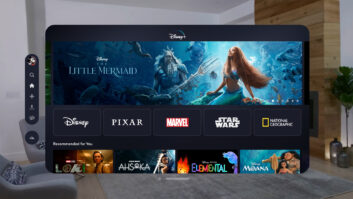An ongoing content arms race has been taking place in the media and entertainment industry for quite some time. First it was Netflix’s vast sum of investment in online content licensing that was leading the industry and providing the audience with new and refreshing content, then Amazon Prime took this business model and made its own version. It wasn’t going to take long until Disney joined in the party with the launch of its Disney+ platform.
It is no wonder that content producers are facing increasing pressure and high expectations from viewers; the broadcast landscape is constantly being disrupted by on-demand, SaaS companies. However, it is only by creating a highly efficient content supply chain can content producers ensure they are both delivering engaging content audiences want and making a return on investment.
Creating a streamlined media factory
According to the Ericsson Mobility Report, on a weekly basis the UK population watches a total of more than one billion minutes of TV content online. A platform’s content supply chain and more importantly its efficiency could therefore either make or break the venture.
It all comes down to powering a streamlined media factory, which means deploying a content supply chain that delivers a great user experience but also stops content producers’ budgets from skyrocketing out of control. As the leader of the over-the-top (OTT) internet content world, Netflix is known for its end-user experience and significant investments in unique content to maintain its 125 million (and growing) global subscribers.
In 2019 alone, Netflix is committing $8 billion towards its investments and making its library 50 per cent original programming. Amazon is falling short only slightly at $4 billion, followed by Facebook and Apple with around $1 billion each. It is still early days to forecast investments for Disney+ but the company has already announced its plans to make all of its film releases under Disney, including Pixar, Marvel and Lucasfilm, exclusive to its platform.
With so many of its competitors pouring giant investment sums into original content, what sets Netflix apart? Its biggest differentiator is in fact its supply chain, particularly when it comes to enabling such rapid expansion into niche, regionalised markets, in a time- and cost-efficient manner. Rather than just localising content for India and the Philippines, for example, it is creating and distributing a significant amount of original programming for these countries at any time and any place.
Providing content for a niche market
A huge volume of content is required to cater for niche audiences and proves a great challenge for content producers. This has a broad impact on the overall business landscape, the content supply chain, and heightens the need for the producer to be certain that each piece of its content is going to be more hit than miss.
With a unique supply chain that is tightly controlled and completely connected, Netflix has an excellent understanding of both the cost of production and which audiences are engaging with what content. Visibility into these datasets enables it to calculate return on investment in content production in ways no other content producer is able to.
The way to improve speed and efficiency in a content supply chain is to connect and manage all its components, making it as flexible and organic as possible. However, that’s not always straightforward because there is still a decided preference for best of breed, meaning most content producers have a non-linear editing suite from a different provider, rather than their media asset management system or encoding fleet, so it’s very difficult to connect their supply chain.
As audiences are more fragmented, producers must store more metadata. As content is localised for more regions, the complexity of the content supply chain has significantly increased both in terms of the assets being managed and the number of distribution end-points. With a disconnected content supply chain, a content producer may need to work with an asset management system, a separate content archive, and different ingest and distribution platforms, all running in silos. To reach and resonate with those audiences, content producers have to manage that complexity without drastically larger budgets.
Such supply chains require rethinking to provide an operations centre; a single point of truth and workflow orchestration across the entire organisation. Then content producers can really start to accelerate efficiencies by automating tasks, previously undertaken by humans, with artificial intelligence (AI) plug-ins, such as Microsoft Cognitive Services or Google Video Intelligence.
Automation is key
Automation has been such a hot topic in the transformation of the media and entertainment industry. It enables content producers to target niche markets around the world on existing budgets by multiplying capability. For example, with AI a content producer could more than halve the time it takes to regionalise a particular piece of content, allowing them to scale rapidly. AI helps customers deal with a much more fragmented market, by automating the process of going after it, and compete in the content arms race by delivering more volume of engaging content to their audiences in less time and a lower cost.
The only way in which Disney+ can compete with Amazon Prime and Netflix, and achieve the same scale quickly, is to shape-up their content supply chain.







